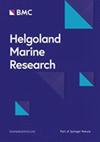An exclusion experiment to study the influence of habitat structure provided by Mussismilia corals (Cnidaria; Anthozoa) on the predation of associated crustaceans
4区 地球科学
Q2 Agricultural and Biological Sciences
引用次数: 2
Abstract
Predation is an interaction between species that influences community organisation by the direct consumption of prey, influencing prey numbers, behaviours and traits. The intensity of predation is greatly influenced by the environment, and the physical structure of habitats may influence predation intensity by providing refuge for prey or reducing the foraging efficiency of predators. In this context, the aim of the present study is to verify the influence of predation on the richness and density patterns of crustaceans inhabiting different species of Mussismilia corals, which provide various habitat structures for the associated fauna. We conducted an exclusion experiment to include total, partial and no cage treatments. The richness and density of crustaceans differed among coral species and cage treatments, except between partial cage and no cage treatment. Mussismilia harttii showed higher richness and density in uncaged and partial cage treatments compared with M. braziliensis, which in turn showed higher values than M. hispida. These findings indicate the importance of predation in the structure of crustacean assemblage associated with Mussismilia species and that differences in the richness and abundance of associated fauna result from the different habitat structures provided by each species of Mussismilia.通过排除实验研究Mussismilia coral (Cnidaria)提供的生境结构的影响;珊瑚虫)捕食伴生的甲壳类动物
捕食是物种之间的相互作用,通过直接消耗猎物来影响群落组织,影响猎物的数量、行为和特征。捕食强度受环境影响较大,生境的物理结构可能通过为猎物提供庇护或降低捕食者的觅食效率来影响捕食强度。在这种背景下,本研究的目的是验证捕食对栖息在不同种类的Mussismilia珊瑚中的甲壳类动物的丰富度和密度格局的影响,Mussismilia珊瑚为相关动物提供了不同的栖息地结构。我们进行了排除试验,包括全笼、部分笼和无笼处理。甲壳类动物的丰富度和密度在不同的珊瑚种类和网箱处理之间存在差异,除了部分网箱处理和不网箱处理之间存在差异。在非笼型和部分笼型处理下,哈氏mussisilia harttii的丰富度和密度均高于巴西黑僵菌,而巴西黑僵菌的丰富度和密度又高于西班牙黑僵菌。这些发现表明,捕食在与mussismila物种相关的甲壳类动物组合结构中具有重要意义,而与之相关的动物丰富度和丰度的差异是由不同的mussismila物种提供的不同栖息地结构造成的。
本文章由计算机程序翻译,如有差异,请以英文原文为准。
求助全文
约1分钟内获得全文
求助全文
来源期刊

Helgoland Marine Research
地学-海洋学
自引率
0.00%
发文量
0
审稿时长
6-12 weeks
期刊介绍:
Helgoland Marine Research is an open access, peer reviewed journal, publishing original research as well as reviews on all aspects of marine and brackish water ecosystems, with a focus on how organisms survive in, and interact with, their environment.
The aim of Helgoland Marine Research is to publish work with a regional focus, but with clear global implications, or vice versa; research with global emphasis and regional ramifications. We are particularly interested in contributions that further our general understanding of how marine ecosystems work, and that concentrate on species’ interactions.
 求助内容:
求助内容: 应助结果提醒方式:
应助结果提醒方式:


